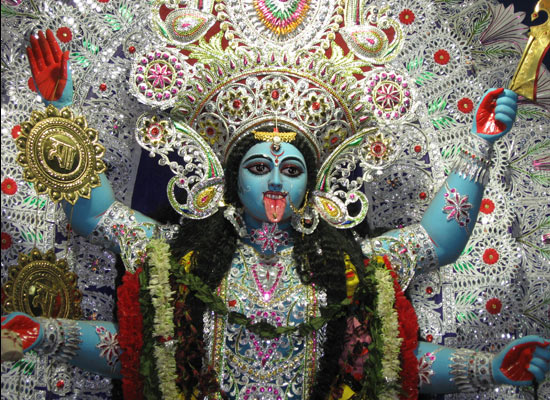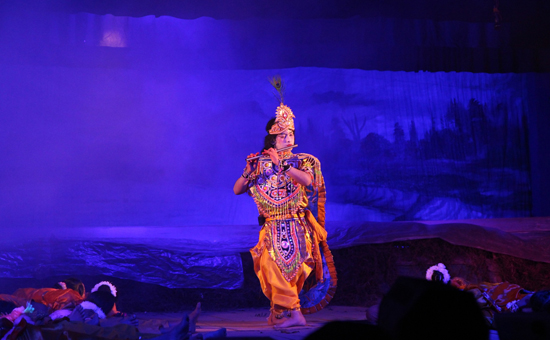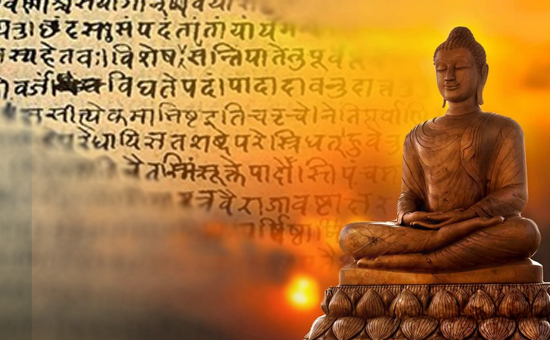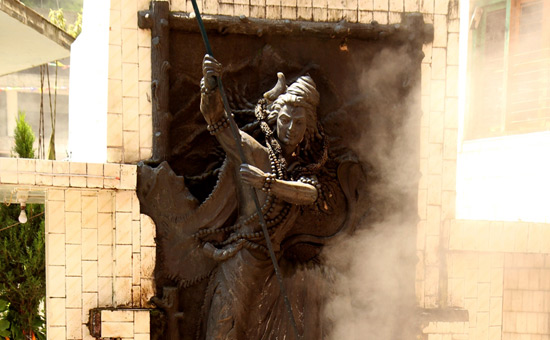-
This is an
excellent prima on the evolution of Sanatana Dharma. The biggest learning is
that what does not change becomes history in course of time.
Sanatan Dharma (also known as Hinduism) is an eternal
concept, the reason why it has become the longest living religion of the world.
The religion flourished despite having its share of ups and downs in its
cherished and checkered history. In comparison, most religions of yore got
wiped out in the sands of time due to external aggression or internal
anarchism, while others which survived witnessed steady decline/ division in
their follower-base.
It
is an interesting enquiry into the oldest religion to understand its basis and
ability to adapt to changes from within and challenges from
without.
Hinduism
flourished
over the millennia
due to a strong
basis in/ focus on Spirituality, evolution and practice.
Hinduism is spirituality-based:
It is based on the philosophia perennis that Self is the permanent
reality/ bliss (also, its opposite, ignorance (Maya), is the root cause
of apparent reality/ misery). Realization of the Truth, that Divinity is
universal, is a matter of faith and not mere belief, it is a matter of understanding
and not mere fantasy.
Hinduism is evolution-oriented:
It is based on the principle that change is an
inevitable aspect of existence; hence, everything needs to stay relevant
in changing circumstances. Resting content with status-quo in practice or
understanding is not a virtue or purpose of life, but evolving through concepts
and contents of creation sure are. This applies even to God‘s’, as they
are an integral part of creation. God ‘evolution’ is part of religious
evolution.
Hinduism is practice-driven: It is based on the premise that for
religious evolution, living its principles is a way of life. Consequently,
practices and rituals at different stages of life are essential elements for
progress through the cosmic-maze/ individual-mania. Worship rituals, the means
to pray and propitiate Gods, also had major role to play in the evolution of
religion.
Of these, many aspects of
Spirituality and Practice are not the monopoly of Hinduism. In fact, they, or
their equivalents (gospels/ canons), are the hallmark of other religions as
well. What really made Hinduism to stay on and stand out was the religion’s
ability to evolve, a fact and factor missed by dead religions.
Religious
Evolution:
Religious evolution essentially centred on:
- The Worshipped (Gods)
- The Worship (Rituals)
- The Worshippers (Followers)
All Gods despite their differing
denominations, and all rituals despite their disparate descriptions, existed in
some form or other. What really happened was fusion of cultures, with followers
appreciating/ accommodating/ assimilating the best parts/ practices of the
other. These qualities turned out to be Hinduism’s saviour during turbulent
years of history, when armed missions and articulate missionaries made repeated
attempts to eclipse it.
1. The Worshipped (Objects-of-Worship):
For Hindus, God is the central theme
of life. But god is not a hard-headed belief, but a broad-minded understanding.
This is confirmed by the marked difference between the Gods the
distant ancestors worshipped and the current generations worship, and that by
itself is a proof that even with respect to Gods we are receptive/
adaptive to changes, a phenomenon unthinkable in other religions.
How did the
Objects-of-worship evolve?
Different
periods of history had different sets of Gods:
The primeval objects-of-worship were the Tutelary Deities/ Vedic Gods.
The medieval objects-of-worship were the Puranic
Gods/ Avatars.
The coeval objects-of-worship are a medley of Gods
and God-men.
The Primeval Gods:
Vedic Gods: They were 33 in number, with no hierarchy (12 Adityas, 11 Rudras, 8 Vasus, Indra and Prajapathi). They were representative of the forces behind the macrocosmic and microcosmic existence. As the Gods were defined by Scriptures, it was a closed-end tradition, i.e. a follower couldn't add or delete a God from the pantheon. Consequently, Vedic worship never
evolved, instead went into decline/ oblivion.
Tutelary Deities: They are the
Gods native to a particular region/ clan, their antiquity paralleling
or even preceding the Vedic ones. Known as Village
Deities (Gram Devata), they were worshipped by a community/ native population from time immemorial. One remarkable aspect of such God-worship was that, despite any amount of advance/ changes in their trade or traditions, the followers' faith never wavered or weakened.
These deities were quite 'earthly' with no fixed pattern in their forms, or purpose in their functions. Anything could be deified by anybody, though some figures (especially the Shakti/ Siva equivalents) were more prevalent/ predominant than others.
 Adivasis of Bastar bringing their Kul Devata during Bastar Dussehra, Jagdalpur.
Adivasis of Bastar bringing their Kul Devata during Bastar Dussehra, Jagdalpur.
The natives had three sets of Gods: Clan/ Community Deity (Kul
Devata) (a female or male deity corresponding to Parvati/ Siva), Guardian
Deity (corresponding to Shiva’s sons, Iyappan/ Karthikeya) and Subordinate
deities (corresponding to Ganas of Shiva).
Female deity was
the equivalent of Goddess Parvathi in Vedic worship. She was considered the
fertility goddess who in Her benevolent form bestowed prosperity and knowledge,
and in Her angry form caused pox and similar ailments. No wonder Shakta
goddesses were revered as well as feared.
Every community
had a guardian deity, which was invariably a male deity (in the Dravidian
hinterland it was called Ayyanar). The Vedic people considered Him more
as a son of Shiva.
The temples of main female/
male gods were invariably in the middle of the community settlements, whereas
that of the male guardian deity was always at the outskirts of it.
Since
there were no regulations for defining or identifying Gods, it was an open-end
tradition, i.e. a worshipper/ community could add/ avoid a God from the
pantheon at will. Tutelary gods evolved over the millennia,
notwithstanding cultural and racial prejudices.
The Medieval Gods:
Puranic Gods: They were the central figures of
adulation in the Puranas. The Puranic Gods were many in number,
with well-defined hierarchy. Ishwars, especially Vishnu/ Shiva
were regarded as the foremost, in importance and power, followed
by Sarasvati/ Laxmi/ Parvati (Devis),
and Ganesh/ Surya/ Kartikeya. Further down the Celestial class, there were Devas, Gandharvas,
Apsaras, Kinnaras, Kimpurushas, Yakshas,
Siddhas, Charanas, Vidyadharas, apart from certain Asuric
Gods like Varuna, Bali et al.
Avatars: They were the
central figures of adulation in the Itihasas (Ramayana, Mahabharata and Shrimad
Bhagavatam). Lord Vishnu’s incarnations were the most celebrated, especially
Ram and Krishna Avatars. Their
elevation and adulation planted the seeds of Bhakti Movement, whose
after-effects are sweeping the different corners of Indian landscape even to
this date.
The Coeval Gods:
Gods & God-men: They are an
inter-mix, sometimes an incongruous-mix of above traditions. Apart from
the Gods, the mix included Vedic saints (like Sage Agastya), Itihasa
characters (like Hanuman), self-realized souls ((like Ramakrishna Paramahansa,
Ramana Maharishi), protagonists of Bhakti movement (the 63-Saivaite Nayanmars/
12 Vaishnavaite Alvars, Mirabai, Tulsidas) and holy-men (like Sai Baba). Many
modern-day (self-proclaimed) cult-leaders also staked claim for the exalted
state, though only a few made the grade!
2. The Worship (Rituals):
Most followers ignore or are
ignorant of the lofty truths in the well-meaning scriptures or well-articulated
sermons. It is the rituals which appeals and attracts the imagination of the
individual as he becomes a participant and not a mere spectator.
Also, esoteric rituals which needed
elaborate engagements or educated elite to execute, or that which let a
more-advantaged group dominate over a lesser-privileged one, or which excluded
main-stream participation withered.
Rituals which encouraged flexible/
egalitarian approach, or which were open to changes survived the odds, while
those which adopted a rigid/ elite attitude
collapsed like a pack of cards.
How did the modes-of-worship evolve?
Shrauta tradition:
It is the tradition based on Shrutis
(Vedas). References to very elaborate rituals, mostly Yagnas (Yaga and
Homam) could be found in the Upasana Kanda of the Vedas. It
compulsorily required an officiating priest, Ritvij. Corresponding to
the Vedic hymns recited, they were called Hota (Rig), Adhvaryu
(Yajur), Udgata (Sama) and Brahma (Atharva). Fire (Agni)
was an essential aspect of rituals, as it was He who was deemed to carry the
essence of offerings to higher regions/ Gods. There was always an expectation
preceding every offering.
Tutelar tradition: While Shrauta tradition was ritualistic (demanding more of
‘head’), tutelary God worship was rustic (demanding more of ‘heart’). Hence,
despite their customs being derided and denigrated by the Vedic protagonists,
they proved more versatile. Rituals were simple with no need for sophisticated Tantram
or Mantram. Offerings to God were mostly flowers, plant items or cooked
food. Cooked offerings to the subordinate-gods sometimes included even
non-vegetarian fare. That meant that there was no dichotomy between their daily
routine and god worship, or hypocrisy between their thoughts and practices.
Though Shrauta tradition is extinct, tutelary mode of worship is still
extant.
Smarta tradition: This tradition revolved around Pancayatana-puja (five
shrine worship) with focus on Shiva (Saiva tradition), Vishnu (Vaishnava
tradition), Shakti (Sakta tradition), Ganesh (Ganapatya tradition),
Surya (Saura tradition). In some places, Kartikeya (Kaumara tradition)
is also added to the pantheon, in which case it is called Shanmata
tradition.
Shakta tradition was the worship
of Shakti, probably the most ancient form of worship. The goddess was
worshipped in a friendly form (fertility goddess) and a fearful form (Kali). Tantric cult and Shakta tradition are closely
related.
 Ma Kali.
Ma Kali.
Saiva tradition of Shiva worship
transcended even the Vedic period. He was worshipped in many names (Shankar as
the destroyer-deity and Maheshwar as the Purusha-aspect of Brahman) and forms
(mostly in abstract form like Lingam, and occasionally in tangible form like
Nataraja). Shaivism had different schools – Saiva Siddhanta, Vira
Shaivism, Kashmiri Shaivism, Natha Shaivism, etc.
Vaishnava tradition was the worship
of Vishnu, mostly as the god-of-prosperity (Lord Venkateshwara) amongst a
select group of worshippers, while His incarnations (Avatars), Ram and Krishna were
more and immensely popular across a wide spectrum of followers. Ram and his
consort, Sita and his foremost devotee, Hanuman, and Krishna are the central
figures in two of the longest epics of Hinduism. Radha, Krishna’s playmate of childhood,
but considered more of his soul-mate by his devotees, is not mentioned in the
epics or even in Srimad Bhagavatham. She and
her eternal love for Krishna was probably the product of Bhakti
movement, and her love symbolized the ultimate form of devotion.
Poet Jaydeva in 12th century and Acharya Nimbarka in
13th century immortalized their devotional-love.
Vaishnavism had
four different traditions (Sampradayas) – Brahma Sampradaya
(Madhavacharya – Vyasakutas & Dasakutas), Sri Sampradaya
(Ramanuja – Vadagalai & Thengalai), Rudra Sampradaya
(Vallabhacharya), Kumaras Sampradaya (Nimbarka).
Ganpatya tradition worshipped Ganapati as the central
deity, and was the favorite of almost all Hindus, despite their Advaita or Dwaita affiliations. He is
worshipped before commencing any endeavor as the harbinger of luck and remover
of obstacles in their secular/ spiritual pursuits.
Saura tradition was the worship of Surya, which had a
place of pride in the Vedic period as well. He seamlessly found a slot in the Smarta tradition too, as He was
the only prominent divinity visible in physical realm. In fact, the most
sacred/ secret/ potent mantra of Hinduism, Gayatri Mantra, is a hymn in eulogy and entreaty of the
Surya devata.
Kaumara tradition was the worship of Skanda (Murugan/
Kartikeya), the commander-in-chief of Gods. He was more popular in the southern
parts.
The Smarta system
of worship probably existed for long, but found rightful space and
importance in/ during/ post Bhakti movement which swept India from the 8th
century, more particularly from the 11th-13th centuries.
The most common mode of worship under the Smarta traditions is Sodasopachara,
the 16-step rituals. The more elaborate pujas needed the services of
an Aagama priest, but the lesser ones were done by a
householder himself. There may or may not be an expectation for doing the puja,
but devotion was always an underlying and unifying thread.
 Krishna Worship, Ras Mahotsav Majuli, Assam 2018
Krishna Worship, Ras Mahotsav Majuli, Assam 2018
3. The Worshippers (the followers):
The followers of
the religion are spread over a broad spectrum of background. Defining the paradigms which characterize the followers, and decoding the paradoxes which confuse the observers can be a
daunting task. While the paradigms confirm followers’ social/ cultural/
spiritual similarity, the paradoxes convey their ethnical, geographical and ideological diversity.
The paradigms
which define a follower: A Hindu is defined by not just an explicit belief in
religion, but also an implicit faith in spirituality. It is not just adopting a
time-tested tenet, but also accepting a contrary view-point. It is not just the
freedom to profess chosen path, but also the willingness to embrace changes en
route. It is not just the ability to stay rooted in traditions, but also an
earnestness to evolve to a higher order.
The paradoxes
which confuse an onlooker: Hindus would fight amongst themselves, but not
resort to armed aggression on neighbors. They would advocate supremacy of a
sect’s philosophy over other, but not their religion over others. They would
fast for religious reasons, but feast in
the name of same gods. They would abstain
from intoxicants on auspicious days (Shravan),
but get drunk in the name of the same gods (Shivratri).
They would ensure handsome donations to an advantaged ‘creator’ (God/ temple),
but not to a disadvantaged ‘created’ (down-trodden). They wouldn’t offer their
hands for wishing a stranger, but relish their meals with hands. They would be
extremely fuzzy about personal hygiene, but would be equally reckless about
public cleanliness.
How did the Followers evolve?
The Itihasas
and Puranic era (5th century BCE) followed the Vedic period
(15th-5th century BCE), initially co-existing, later
eclipsing it totally. The Vedic worshippers had a very rigid regimen and
they had no freedom to pursue anything to the contrary. The tutelary deity
worship was more laissez-faire, affording freedom to worshippers.
Due
to the stranglehold of the people from the higher strata, and non-participatory
nature of Vedic worship, there was mass exodus of people, largely from the
lower strata of society.
Enter
now Mahavira. Some claim that Jain religion is much older, perhaps
starting with Rishabha, the great-great-grandson
of Swyambhavu Manu, and ending with the 24th Tirtankara, Mahavira
(around 6th century BCE). Jainism had patrons among the ruling
elite, therefore flourished due to state support.
Buddhism
came into existence almost at the same time as Mahavira (6th century
BCE). Buddha’s message was simple and universal. It preached and practiced
egalitarianism with no social stratification. Buddhism had mass following.
With its focus on middle-path (Madhyama Marg), it spread far and wide
very rapidly, even to the far-east countries, where it is a major religion now.
The
rapid spread of Jainism and Buddhism during the centuries preceding and
following Common Era (5th century BCE to 5th century CE),
caused rapid erosion in the ranks and ratings of Hinduism. The turmoil was more
pronounced in the northern parts due to diffused and shuffling political
landscape. Fortunately, south was relatively free of these headwinds and the
tranquil environment spawned a brand of Bhakti movement.
 Buddha
Buddha
5th-6th
CE onwards, Saivaite Nayanmars sowed the seeds of Bhakti movement in
south India. But unification of the divergent and distraught Hindus had to wait
for few more centuries, not until Shankaracharya entered the ‘revival-battle’
in the 8th century. Within 32 years of event-filled life, he managed to bring all the drifting and disparate sects of Hinduism with a gospel message that every/ everyone's God was an aspect of ultimate truth, and that any/ every mode of worship was acceptable to god, if performed with love and faith.
Overnight,
Smarta tradition found its bearings. In Smarta system, a follower
became a ‘proximate’ participant, unlike a Yajna, where he was a
‘silent’ spectator! This appealed to masses and Hinduism retraced its lost
glory over the next few centuries. Thus did Shankaracharya bring the ideologically drifting and geographically
spread-out sects back into the folds of mainstream Hinduism almost single-handedly?
Though Vedic ideology
dramatically differed from the local traditions, the Vedic
people were in total sync with the native population. There was a
healthy mixing of different strata of the society.
Veda
Vyasa, for example, was born of Parashara muni and a fisher-woman, Satyavati.
Vyasa’s guru, Acharya Gautama was married to Sharmi, a tribal girl from the
Godhuli village, so was Sukha, Vyasa’s son, to Peevaree, a sister of
the tribal chieftain. Such inter-mingling of people even at the highest level,
facilitated the fusion of cultures then and even much later.
Unity in diversity – where/ how did the traditions
concur/ differ?
In
Vedic God worship (Shrauta
traditions), Idols (Yantram) were
unknown, while Mantram was the major
means to address Gods, with Tantram
(rituals) playing a subsidiary role.
In
Tutelary God worship, Idols (Yantram)
were essential aspect of worship, with Tantram
(Rituals) complementing the worship regimen. Mantram was unknown.
In
Puranic God worship (Smarta
traditions), Aagama Shastras defined
exacting specifications for Yantram
(for Idols and Temples). 16-step-rituals, in full/ part (Tantram) was an essential aspect of worship. Chanting of Mantram, and Bhajans/ Kirtans in its absence (sometimes in addition), completed
the worship protocols.
Gods were more
‘heavenly’ in Shrauta traditions, whereas the Tutelary Gods were more
earthly, that is, the followers could see God in human forms (some people would
get ‘possessed’ by the deities (ritual shaman dance), called ‘Sami Aadis’
in Tamil, literally dance of gods). Communicating with the tutelary gods was
very easy, as the gods (in the form of ‘possessed’ revelers) would talk the
native tongue (an oracle). It was almost impossible in the Vedic tradition, as
the language (Sanskrit) and the intermediaries (Brahmins) acted as barriers to
free communication.
The Puranic
idols were sculpted to exacting specifications, whereas the Tutelary gods were
not as portly, mostly made of mud or in some cases even a simple stone. Temple worship was foreign to Vedic culture,
which believed in Homas and Yagas to invoke/
propitiate Gods.
Smarta tradition is a fusion of cultures; it borrowed the Temple culture of
natives and the worship rituals of Shrauta culture, which appealed to the entire spectrum of Hindu devotees.
Vedic people
never had temples, nor idols for worship. They would erect a place for Yaga-Homa and
destroy it after the puja. Consecration and dismantling the Yajnakund
were part of the rituals. In comparison, tutelary gods always had a place for worship, either within the core settlement or in the near periphery or in the yonder wilderness. The natives didn't have elaborate worship or Samskara rituals. Hence, services of a learned pandit
were not a necessity.
It
was common for community members to perform rituals.
In a fusion of
cultures, and over a period of time, the Smarta tradition accepted the
fixed-place (temple) worship-concept of the natives and the worship rituals of
the Vedic people. Also, most of the native gods were absorbed into the Hindu
pantheon as aspects of Shiva-Parvathi or their descendants.
Family deity (Kul
Devata) was an essential element in native worship. In Smarta
tradition, Personal deity (Ishta Devata) had a prominent and preeminent
position. Shrauta tradition never presented options.
The Smarta
tradition of God-worship was a mid-way point, where a worshipper had the
freedom to choose a God (like natives) from a galaxy of them (like Puranic
gods). Even the worship could be effected with a simple offer of
flower (like natives) to an elaborate set of Upacharas (like Vedic).
 At ancient Shiv Mandir
Manikaran, Himachal Pradesh. Known for hot water springs.
At ancient Shiv Mandir
Manikaran, Himachal Pradesh. Known for hot water springs.
Shiva worship is a typical example of the fusion of
cultures:
Amongst Vedic
lore, there was no concept of Destroyer. They worshipped 11 Rudras (the
ferocious ones, probably representing wind/ storm).
Amongst Tutelary
gods also there was no concept of Destroyer either. There was a female goddess
and her consort was Ayyan (in south India).
Shiva (meaning
the auspicious, representing Destroyer) was a later addition to the Puranic
pantheon.
When Bhakti
movement swept through the Hindu landscape, the Vedic Rudras and the tutelary
‘Ayyan’ got ‘merged’ with Shiva. True to the saying, ‘all is well that ends
well’, the merger was seamless and successful.
Bhakti movement was a blessing:
The latter day Dvaita
practitioners literally usurped/ hijacked the Saivaite-initiated Bhakti-oriented
Smarta traditions, but that only added muscle and momentum to the
renaissance rather than undermining the original premises of Advaita
practitioners.
The
Bhakti movement, though it remarkably contributed to the arresting of
the spread of Buddhism, yet, produced its share of problems, with Advaita
and Dvaita followers fighting for supremacy.
Once again,
tutelary deities were called in to subdue frayed tempers. A guardian deity of
Dravidian hinterland, Ayyanar, came handy for resolving the Saiva-Vaishnava dispute. He was
considered as the son of Vishnu (Hari) (Vishnu as Mohini) and Lord Shiva
(Hara). Ayyanar became the famed Hariharaputra, also called Sastha or Aiyappan,
who then became a rage in the sub-continent.
Fortunately,
by the time Mughals came in the 14th-15th century, the reforms and Bhakti
movement had firmly taken root. So deep was the foundation and so strong was the edifice that the fervour or the fatwas
of the new rulers failed to make a dent in the structure and solidarity of
Hindus.
Centuries
later the British attempted to shake their basic faith, but without success.
However, their strategy to break the unity on caste lines met with enormous
success. (Remember, Hindus loathe
to fight external war of aggression, but love to fight internal sects to the
last man).
The
solidarity of the religious milieu became a main plank of launching freedom
movement by some leaders like Tilak, Aurobindo, during British rule.
But the caste-division still continues to haunt the society even now.
 Maharshi Aurobindo. Read his writings in India’s
Rebirth to know Bharat.
Maharshi Aurobindo. Read his writings in India’s
Rebirth to know Bharat.
THUS,
Self/ Truth is supreme in Indian Spirituality. It
considers even God as an ‘extension/ symbol’ of
this truth.
Hinduism flourished because it was open to evolution
even with respect to Gods, something unimaginable/ blasphemous in most
religions. Hinduism was not dogmatic even with respect to their Gods; hence, it
had no qualms in adopting different Gods that accommodated people of different
geographical/ ideological background, or that evolved with their aspirations/
understanding.
Unlike evolution of human (thoughts) which takes
place over a few years, and that of human (renaissance) which takes place over
a few decades, and that of humanity over a few centuries,
the god evolution in Hinduism took place over a few thousand years.
Surprisingly, from the orthodox Dravidian heartland,
where Vedic religion played second fiddle to tutelary god-worship, arose the
three pioneering religious reformers of Hinduism, Shankaracharya, Sri Ramanujar
and Madhavacharya, and their historic schools of thoughts, Advaita, Dvaita and
Vishistadvaita.
Surprisingly, it was the upper-caste leaders who
initiated the religious renaissance initially and sustained the Bhakti
movement subsequently.
Surprisingly, it was the principal proponent of Advaita
who seeded the bhakti concept, a distinguishing mark of Dvaita,
as a means to get the drifting masses back in the fold of Hinduism.
OM Namah Shivayah
Author is an Alumnus of BITS, Pilani (MPharm). He worked with some of India’s best MNC Pharma companies. Currently writes articles on Spirituality. One book, Spirituality - A Roadmap is published. The next book, 'Mindfulness - A Roadmap' is ready for publication.